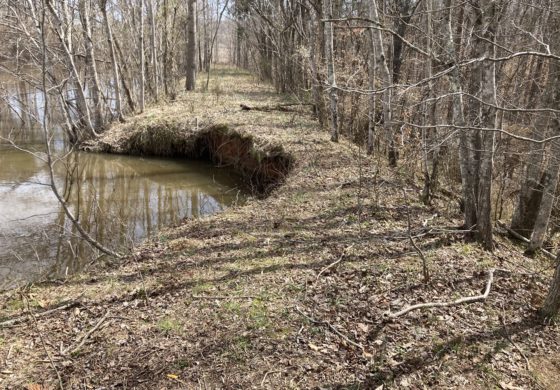By Heather Michon
Correspondent
County and state officials worked last week to keep a private dam near Bremo from collapsing, a failure that could have sent millions of gallons of water spilling into nearby Holman Creek and down to the James River near the coal ash ponds at Dominion’s Bremo Power Station.
The Department of Conservation and Recreation (DCR) brought in pumps that were capable of removing 1,000 gallons a minute to relieve the pressure on the dam. By March 28, County Administrator Eric Dahl said the water level had been pumped down by about ten feet.
According to state records, the McIver Dam was built in 1969, creating an 11-acre lake with a maximum capacity of 150 acre-feet of water, corresponding to about 49 million gallons of water. The last known state inspection of the dam took place in 1990.
The county learned that the dam at McIver Lake was at risk of imminent failure at around 2 p.m. on Monday (March 21). By 7:15 pm, Governor Glenn Youngkin’s office had authorized the county to take “all prudent measures” to keep the dam from collapsing.
“Even though the Department of Conservation and Recreation has indicated there are no homes impacted in the inundation area, the Fluvanna Sheriff’s Office notified homeowners in the area about the potential failure,” said Assistant County Administrator Kelly Belanger Harris in an email to the Fluvanna Review.
VDOT also closed Bremo Road (Rt. 656) from the intersection of Bremo Bluff Road (Rt. 657) to the 1400 block of Bremo Road. If the dam were to breach, there was concern that fast-moving water could come over Bremo Road, putting motorists at risk. That road remains closed as of Monday, March 28, out of an abundance of caution.
Dominion Power said in a brief statement that they were “monitoring the situation with the McIver Lake dam in Fluvanna County and are working closely with the county and state agencies. Safety is always our top priority, and we are taking the necessary precautions at Bremo Power Station and with other infrastructure to protect people and the environment.”
Harris said there was no coal ash in the pond closest to the inundation area, in the event the dam did fail.
The property owners do not live on-site, and it was not clear to Dahl who was monitoring the property. According to press reports, the lake had been empty for decades and only refilled in recent weeks, although some residents indicated it had been filling over a longer period of time.
Dahl said he believed the property owners or someone acting on their behalf was working on removing the dam and may have called in engineers to come up with a plan for dismantling the structure when the damage was discovered. The engineers contacted the DCR, who sent in their staff to inspect the site. The DCR notified the Virginia Department of Emergency Management (VDEM), who then notified the county.
He said Governor Youngkin’s order “allows the county access to take the appropriate actions,” and he and his staff were working closely with DCR and other agencies to continue to mitigate the immediate risk and, at a future point, remove the dam.
The incident threw a spotlight on the difficulty of keeping tabs on nearly 2,000 such dams scattered around the Commonwealth. According to Sarah Vogelsong of the Virginia Mercury, DCR rules require private dam owners to submit an annual report and undergo an engineering inspection every one to six years, but owners often fail to adhere to those regulations.





